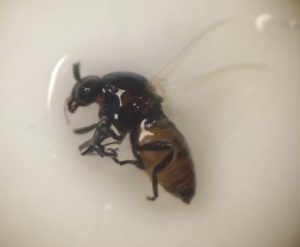
A trapped black fly studied by the Texas A&M AgriLife Extension Service. Conditions are right for the black fly to have a prolific spring and summer, according to an AgriLife Extension specialist. (Texas A&M AgriLife Extension Service photo by John Gordy)
By Adam Russell, Texas A&M AgriLife Communications
STEPHENVILLE – Reports of black flies are increasing as recent rains created favorable conditions for the swarming, biting pest, according to Dr. Sonja Swiger, Texas A&M AgriLife Extension Service entomologist, Stephenville.
Black flies aren’t like run-of-the-mill house flies or other biting flies, such as horn or stable flies, Swiger said. They’re tiny, powerful blood-feeders who aren’t picky about their host. They attack humans as readily as domesticated animals and wildlife, and feed at various times throughout the day.
“They’re nasty biters,” she said. “They’ll attack anything with blood but they prefer animals.”
Swiger said she has received a higher number of calls about black flies this year and suspects spring rains have created perfect breeding grounds for the pest. A mild spring may have also provided better conditions for the temperature-dependent fly, which usually is active throughout the summer.
Black flies are especially problematic in northern and eastern Texas where water is plentiful, but the rains may expand their habitat, she said.
One recent case in East Texas involved the loss of more than a dozen adolescent chickens, according to the caller, Swiger said.
Black flies have been known to kill animals by sucking blood or suffocation from clogging or covering up airways, she said. The flies also carry diseases. Black flies’ flight patterns are dependent upon the wind, light, temperature and host availability.
Swiger said as with any pest it’s better to deal with black flies by addressing them before they reach adulthood, but the flies’ breeding habitat makes it difficult to kill eggs and larvae.
Eggs and larvae stick together in flowing water, such as creeks, attached to vegetation or rocks. Immature black flies can live in habitats ranging from trickling water to rivers.
Bacillus thuringiensis israelensis products, which are better known for controlling mosquitoes, can be used to kill black flies in the larval stage.
Black flies lay between 100-600 eggs, so one hatching could pose problems to a landowner because they grow together and move in swarms once they reach adulthood, she said. Several generations can reach adulthood each year.
“They’re not easy to find, but if you have a running creek nearby or have had a problem with them in the past you might see them again this year,” she said. “Target areas around vegetation and rocks in flowing water.”
Swiger said repellants with diethyl-meta-toluamide or DEET, are supposed to be effective against them but added that female black flies are determined feeders once they find a potential host. Permethrin can be applied to animals to repel and kill black flies, she said. Dabs of petroleum jelly around the sensitive areas of animals, such as the nose, ears and eyes, can prevent bites and the pest from congregating.
“The fact that they are fully aquatic and their habitat is flowing water can make them tricky to deal with but it might be worth looking,” she said.
For more information about black flies and other insects and pests, visit http://livestockvetento.tamu.edu.